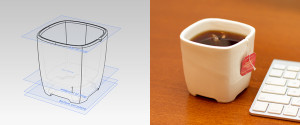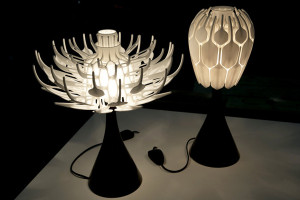3D Printing Technology: 5 Ways of Redefining Consumption
Will 3D-printing technology bring a revolution to Christmas shopping lists? If you can just print that iPhone case, why ask Santa? We’re going to go forward a few years, when the 3D printer has been welcomed in the majority of our homes. How will we look at the ‘simple’ process of buying stuff? It has already become a lot more complicated for those who couldn’t keep up with the rise of the computer, with easy-and-cheap webshops, mobile payments and internet banking. Their heads will explode if they find out what potential 3D printing technology really has…
1. Recycling will become the standard
So you’ve just printed a coffeemug, that didn’t come out quite the way you wanted, or maybe you just don’t want to do the dishes, no problem! Just throw it in the plastic melter and print it again. As 3D printing technology is advancing, soon we will be able to print objects using much more sorts of material. All those plastic bags and packagings you get in the supermarket can be re-used to make other useful stuff, without throwing anything away.

When we are able to download the designs we want printed on our computer, immediately and on the spot, there will be less products bought in regular concrete-and-morter shops. Less transport will be required to fill up the shops, and warehouses can shrink to smaller sizes.
2. 3D printing technology ≠ mass production
With which mass-produced Ikea vase do YOU want to express your individualism? As you can see, mass production is the exact opposite of being able to be unique, and having stuff that is designed for its user, you! Well, those times are behind us now that 3D printing technology is on its way. As you are browsing through a selection of designs on the internet, you stumble across some sort of tupperware lunchbox, but you’re not pleased with the way it looks. The dimensions are too big, yet there is no place for holding a banana. Your young son, who has grown up along with the rise of the printer, knows how to use a design programme for making and editing printing designs. In a matter of minutes, the dimensions of the box are adapted, and a banana-holder has been ‘glued’ to the top of the lunch box. Okay, this is just a silly example of making something that fits your needs entirely, but the truth is that with the rise of 3D printing technology, customization will be as important as the creation itself.
3. Priceless info vs. expendable objects
Give a man a fish and he’ll eat for a day, teach him how to print his own rod and he’ll eat for a lifetime. For the generation of kids growing up in the era of 3D printing technology, this might be the case! Don’t believe me? Let’s say you’ve forgot your small-and-banana-holding lunchbox at the subway! It was só you! Now what? Well, nothing. Just print out another one at home, after all, you’ve saved the design when you customized it. And again, it saves you the trouble of washing it off… As you can see, when we’re able to make the objects we use in everyday life in our own homes, the value of an object will completely change. Who cares if your son broke that vase? Make him put the pieces in the recycler and print a new one. All that matters is that there is a design available, and filament. How much more fun it will be to pick out presents! And give them more often, offcourse. 3D printing technology will shift the focus from the concrete object to the information it holds.
4. The return of craftmanship
So, more appreciation for the design, and less of ‘just wanting to have it’. This will be a huge change in the average consumers’ psyche. No longer will cheap be equal to mass-production, now it can go along with unique, personalised and an expression of one’s self. Maybe your grandfather made a table that still has value to it today. Maybe just emotional value, but that’s enough. 3D printing technology will make it possible to revive that good old craftmanship.

5. Tailored products will become cheaper
No, I’m not talking about your suit just yet. Think of tailored products like the knobs for a specific type of car, a replacement part for a vacuum cleaner, or a cutlery drawer divider. Stuff that needs to fit specific stuff. At this moment, where we’re at the beginning of the 3D printing technology era, it is difficult for manufacterers to produce these products cheap. This is because each different version of it (for the different types of stuff it needs to fit) can only be produced in small amounts, because the demand for the product is spread out over these different versions. Back into the future, when the 3D printer has made its way into our homes, the manufacterers only have to make the design available for download. No need to set up different types of production lines, no need to guess how big it needs to be. Much cost, so saving. Wow. These cost savings can result in cheaper products, if market competition does its work.
You've seen ways how 3d printing technology is able to change our lives. What do you think, will it happen? Will it make us evolve out of our consumer-driven minds, or will the true blessings of 3d printing technology be overlooked? Share your view!

